| |
There is nothing we like better than a mystery that involves old
photos of tanks, the Internet, people all over the world, interstate
phone calls and letters moving at the speed of US mail, nearly
forgotten long ago days and message board arguments … did we mention
global begging? Everyone involved had opinions, things to add and
things to say. There was discussion and argument but in one key area,
everyone agreed … there was something really interesting about …
Bill Heflin’s Panthers
Out of the Attic
Eaglehorse.org receives a few e mail messages each month from people
sending corrections or additions to existing text, requests for larger
or more clear copies of on line images and contact information
requests for troopers whose names appear somewhere on the site. We
comply whenever possible. A few weeks back, we received a message from
Stephan from Belgium, a model builder and photo collector, asking for
a 1200 dpi digital copy of the image of the German Panther tank wreck
found in the 926th Signal Battalion Hidden Story. We had returned the
original photograph to the contributor, Bill Heflin Jr., over a year
ago; our “ file “ copy of the image was in 72 dpi size, suitable for
the Internet but not worth much for image printing. Although we had
not exchanged letters with Bill for many months, we wrote, explained
the situation and asked to borrow the photograph once more. Powered by
a 37 cent stamp and our best intentions, the letter set sail.
About a week later, a small package arrived from Maryland; Bill Heflin
had not only sent the photo we requested but four other photos taken
in the woods and meadows not too far from Manteuffel Kaserne that
showed other destroyed Panther tanks he had photographed that same day
in 1946. While there was plenty of time for the Town and Country Club
at night, armed with his camera and good walking shoes, there was just
too much to explore to stay in the barracks on a Summer day. Down from
the attic and into the mail, Bill was more than happy to help out with
his photos once more.
Although the photo safari had occurred almost fifty years ago, and
much of the detail was lost, he did recall the site of the wrecks was
within walking distance of the barracks but certainly not within the
city limits of Bad Kissingen. In his note, Bill wondered if he had
taken the only photos of those tanks, this seemed odd because he
thought their location was generally known by the occupation troops in
Bad Kissingen. Perhaps with the war over for only a year, destroyed
German equipment in the countryside just wasn’t that novel. We sent
the appropriately sized scans off to a very happy Stephan in Belgium
and set about the task of sorting out the mystery of Bill Heflin’s
Panthers. Although our conclusions are built largely on circumstantial
evidence, here is our best effort to recall the tank battles that
occurred within earshot of Bad Kissingen in 1945.
A Final Flickering: The End of the 2nd Panzer Division
As noted in The First Americans Hidden Story, combat operations in the
former Eaglehorse area of Germany saw a major push by several US
divisions from the W-SW to the NE in a corridor running from
Frankfurt-Aschafenburg toward Meiningen. The plan then called for a
turn almost due north, oriented on the central German cities of Erfurt
and Jena. The objectives were to destroy remaining Nazi forces and
link up with the advancing Soviets across a broad front. As part of
this scheme, the US 3rd Infantry Division and 14th Armored Division
were on the eastern flank of the drive; Bad Kissingen was a minor
objective.
In late March-early April 1945, the German military still rallied
forces to the defense although the outcome of the war was not in
doubt. Severely depleted divisions, Volkssturm units of hastily
trained old men and ad hoc battle groups made up of soldiers from
troop training centers were hastily dispatched to defend key areas,
set up ambushes and even conduct limited counterattacks.
In late March, what was left of the once powerful 2nd Panzer Division,
commanded by
Major General Meinrad
von Lauchert had been rendered
combat ineffective by constant American attacks. The division was
penned against the western bank of the Rhine River. A highly decorated
and skilled panzer commander, Lauchert ordered his command to cross
the river by any means possible; for many, this meant rafts, small
boats or as Leuchert supposedly did, by swimming.

After taking stock of the situation, Lauchert, who had brilliantly
commanded the unit during both the Battle of the Bulge and then
delaying actions once the US forces regained the initiative, saw no
point in the continued fight. He said farewell to his small staff and
began walking home to his family in Bamberg. His war career had
started in that city as a company grade officer in Panzer Regiment 35,
part of the 4th Panzer Division. Whatever the future may hold for the
Reich, he intended to find his family. This left what remained of the
2 Panzer Division without a commander. The survivors notified their
higher headquarters, organized themselves into march columns and
headed east.
On 25 March, in the German state of Hesse, Major General Oscar Munzel,
recently returned from the Eastern Front and currently assigned as the
Commander of the Panzer School at Bergen, was directed to create a
combat unit by assembling the school staffs and any available trainees
from a wide array of training centers in central Germany. He moved
into the combat unit chain of command and reported progress to 7th
Army HQ. He also apparently was placed in command of the 2nd Panzer
Division even though it was over 80 kilometers away and he had almost
no communication with the unit.
In the last week of March, with a small staff, he organized the
consolidation of the Thuringen Panzer Brigade by road and rail. It was
a daunting task, most of the units lacked all but the most basic
equipment. At the Panzer School, Munzel had close to 40 operational
tanks but could not get the transport to quickly move them to the
Brigade assembly area near Fulda.
In groups of 300 to 400 men, the training staff units assembled and
were organized on the fly. A Flak Regiment had lost its anti-aircraft
cannon when their train was shot up by US forces at Hammelburg. They
were redesignated as two infantry battalions. The NCO School provided
a much needed cadre of combat experienced instructors, he thought of
using them to “stiffen“ the units consisting or new recruits but
finally decided to keep the NCOs as separate unit, his emergency
combat reserve. NCO candidates from another school were leavened into
the inexperienced units. He was offered over 500 officers from the
Reserve Command Army Personnel Office but initially declined, seeing
no point in sending them to slaughter but reconsidered and assigned
150 of them to help defend Schluctern.
The Brigade was desperately short of combat vehicles, a few platoons
of light anti tank Hetzers were added, a few assault guns were found.
There were almost no supply trucks and only a few horse drawn wagons.
To make matters worse, the US forces were now applying pressure on the
Fulda area and Munzel was ordered to commit the Brigade to combat.
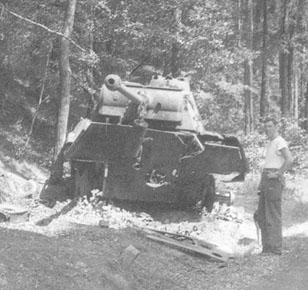
Initially, Munzel was able to deploy a screen backed up by an anti
tank company and some infantry units. He hoped to finish the
organization of the Brigade, his tanks from Bergen failed to arrive
and Hetzer unit from Wildflecken was caught on open roads and
destroyed by US forces firing into a narrow valley. The combat
pressure began to fragment his hasty defense near Fulda and for nearly
18 hours, he was out of touch with the situation, his staff car had
broken down while he was in the front lines forcing him to walk back
to his HQ.
On 2 April, the Brigade was in place along the Kinzig River valley,
basically defending the Fulda area. The same day, the march columns of
the 2nd Panzer Division arrived, their combat equipment was limited to
what they could carry by hand. The following day a few other small
combat units were added and Munzel no longer had contact with the
German divisions operating on his flanks, they had withdrawn to the
east and were in the Meiningen area. The American pressure resumed to
his front, Munzel was directed to turn the command over to Colonel
Carl Stollbrock and make his way to the Wehrmacht High Command-West in
the Hartz Mountains.
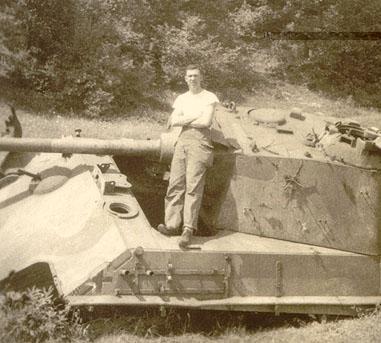
This final change of command for the division has an interesting
sidelight. Why did it occur? We can only speculate, there appears to
be no written record, however, Munzel was very highly thought of and
perhaps his friends in the High Command did not see the point in
sacrificing his life for the dieing Reich. The move was fortuitous,
Oskar Munzel survived the war, was instrumental in rebuilding the
Bundeswehr in 1955 and rose to its senior command level. The wide
array of units that Major General Oskar Munzel had assembled during
the previous weeks were incorporated into the 2nd Panzer Division.
The new and final commander, Colonel Carl Stollbrock
had recently departed his assignment with the Instructor Staff for
Senior Armor Officers and then graduated from one of the final classes
of the Division Commander‘s Course. The fortunes of war had seen the
month long course move from its usual location in central Germany to
Bad Neustadt. In a wonderful twist of fate, as the division departed
Fulda with a march route of Meiningen-Bad Neustadt-Bamberg, Stollbrock
was locally available and now officially qualified to assume that
level of command.
The 2 Panzer Division was first built in this region only nine
years earlier. Stollbrock, following command of an anti tank
battalion, had joined the division after its move to Austria and
successfully commanded the 2 Kradschutzen Battalion in combat in
Poland and France. Later, he was a staff officer, a regimental
commander, an instructor and had briefly been the acting commander of
the 26th Panzer Division. A lot had changed in a fairly
short period of time and although the specifics are lost, it appears
as though he assumed command of the division in Meiningen. The
battalion he commanded in 1940 probably had more combat power than the
division he now led. The specific mission of his unit is not clear. It
was headed towards southern Germany or the mountains of
Czechoslovakia, perhaps the final destination was the rumored “Nazi
Alpine Redoubt“. The immediate mission was to avoid being trapped by
American units trailing him from the west or approaching from the
south. 
The specific
strengths of this unit are not accurately known, it probably
numbered under five hundred men equipped with infantry weapons. There
was very little transport, maybe a few trucks and the usual horse or
donkey carts. Along the way, some light artillery had been added, a
few anti tank guns, some rocket-artillery. Everything was streaming
east away from Fulda. It was an armor division armed with rifles,
hardly much more than a rifle regiment of recruits, training cadre and
the hard core survivors of Lauchert’s last fight on the Rhine. As they
neared Meiningen, a pleasant surprise, 12 late model Panther G tanks
and crews from the Grafenwoehr Training Command joined the division.
Colonel Carl Stollbrock, commander of the 2nd Panzer Division, once
one of the premiere armor divisions of the Reich, finally had some
tanks.
Why he chose to commit his last Panzers is a matter of speculation.
His “division“ was passing through Meiningen and he may have thought
he could briefly delay the American forces in some of the narrow
valleys north of Bad Kissingen. If his subordinate commanders choose
their terrain well, this might buy a few additional hours to further
the escape. Maybe he felt he would soon loose the tanks to air attack
if they continued with the march, he might as well commit them in
ground combat where the terrain favored a defender. Perhaps the
mission was a daring counter attack that lost its way. The fine detail
on the German side of the map is lost.
The Winners Write the History, the Search for the Story
The German language sources at our disposal offered very little to
help us further unravel the story of Bill Heflin’s Panthers. We had
much better luck with the works of US historians. The same pages of
Taggart’s The Third Infantry Division in World War II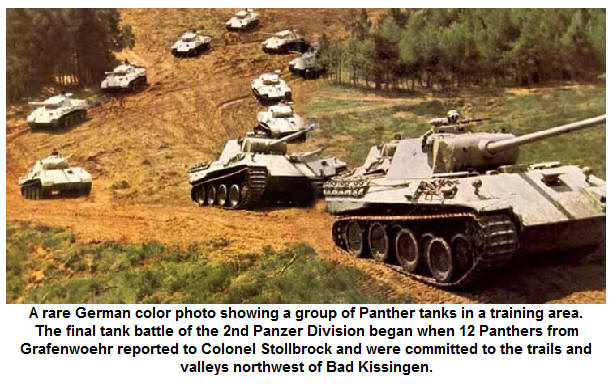 and Vernon
Brown’s memoir of service with the Troop D, 94th Cavalry, 14th AD,
Mount Up! We’re Moving Out! , that recalled the first American forces
at Bad Kissingen also recall the clashes with German armor in the
nearby countryside. and Vernon
Brown’s memoir of service with the Troop D, 94th Cavalry, 14th AD,
Mount Up! We’re Moving Out! , that recalled the first American forces
at Bad Kissingen also recall the clashes with German armor in the
nearby countryside.
Many of the accounts were similar, scouts in jeeps or infantry forces
were heading north-northeast in the areas just east and north of Bad
Kissingen when they suddenly faced German Panthers with infantry in
support. It may have been that the same ten or twelve German tanks
were encountered by several different units until they ultimately were
destroyed. Bill recalled the Panther hulks being within walking
distance of Manteuffel Kaserne; we limited our search to events
occurring with 12 kilometers of the barracks. Note that Taggart’s work
was based on first hand accounts and hastily written after-action
reports and Brown’s memoir was written forty years after the events,
sometimes the recollections, map directions and flow of battle may
contain understandable errors.
6-7 April 1945-General Situation
Regiments of the 3rd Infantry Division have fought a brief battle at
Wildflecken Kaserne and move SE though light contact, towards Bad
Kissingen. The 7th Infantry Regiment is tasked with the area east of
Bad Kissingen while the 30th Regiment will secure the city and
immediate surrounding area. The 15th Regiment is also in the area. The
infantry are in trucks or amphibious “ ducks “, there is an attached
M10 tank destroyer company, elements of the US 14th Armored Division
are also in this exact same area.
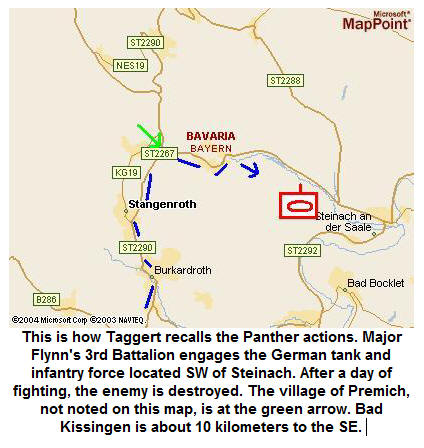
Taggert (3rd ID)
Major Flynn’s 3rd Battalion, 7th Regiment, picked its way over the
rough roads and rugged terrain to Stangenroth from where it jumped off
to take the deserted villages of Premich and Steinach. Continuing
north, the battalion approached a roadblock consisting of three Mark V
(Panther) tanks, three anti tank guns and nearly a battalion of enemy
troops southwest of Steinach. The battle rages all night long and into
the next day, when two of the three tanks were destroyed by accurate
fire of Company A, 601st TD, commanded by Lt. George Philipovich. The
Germans brought down accurate artillery fire and salvos of Nebelwerfer
rocket fire and rushed additional armor into the fray in an effort to
stem the tide but finally retreated before the continuous pressure of
the 3rd battalion. In all, the enemy lost twelve Mark V (Panthers)
during the struggle.
Taggert reports that the battalions encountered other ambushes and
localized counter attacks in the area but these were conducted without
armor support. By 9 April, the division was moving through the Bad
Neustadt area and swinging further east towards Schweinfurt.
Taggert reports that the battalions encountered other ambushes and
localized counter attacks in the area but these were conducted without
armor support. By 9 April, the division was moving through the Bad
Neustadt area and swinging further east towards Schweinfurt.
Brown (Trp D-94th Cav / 14th AD)
April 6 began as just one of those days. Jumping off at first light,
we raced through Paltz, Burkardorf, Stangeroth and Steiberg to Premich
before we ran into trouble. … Leaving Premich, however, Troop met four
Tiger tanks (I believe he incorrectly recalls the type, they are the
same Panthers that Taggert recalled) with mounted infantry, coming the
other way on a narrow mountain road, and in the action that followed
we lost two more armored cars and two more Peeps (scout jeeps)
Lieutenant George Bennett was killed, and popular SSG Dallas Schuler
took over as Platoon Leader of the 3rd Platoon … we pulled back into
Premich.
Happily, we had an M36 tank destroyer from the 636th TD Battalion
attached to us for just such an occasion and he began to fire high
velocity 90 mm armor piercing ammunition at the lead Tiger…. The
gunner of the tiger began to fire back and the duel was on, to end
when our gunner put the forth round in the ground just in front of the
Kraut tank, in such a way that it ricocheted up into the crank case,
smoke appeared from the engine, the crowd cheered wildly and the tank
stopped where it was blocking the road which gave second thoughts to
the others who pulled back.
We retuned to Stangeroth that night after calling for artillery fire
on Premich.
After a night of mortar and rocket fire on their position, the men of
Troop D and Vern Brown’s scout platoon headed north, by-passing the
Germans encountered on 6 April.
Brown
The next morning, with the 1st Platoon at point, Troop advanced
towards Sandberg arriving around noontime to find that there was a
platoon of four or five Tiger ((I believe he means Panther)) tanks
along with mounted infantry on the other side of a small bridge just
east of the town. Troop HQ somewhere to the rear, found this difficult
to believe as they had been assured the Krauts had cleared out of the
area, and as our orders were to continue on through to the east, they
opted to send Jim Taibi’s section of the 1st Platoon on ahead to scout
the situation. The news that Troop intended to send two Peeps and an
armored car out to meet a platoon of Tiger tanks all mounting 88 mm
cannons, to say nothing of their supporting infantry did not sit will
with those involved in the adventure … the day was saved by the
arrival of a battalion from the 3rd Infantry Division, who promptly
attacked down the road ably supported by M4 Sherman tanks, M36 tank
destroyers and some ½ tracks … Troop departed in their favor and
departed Sandberg for Zollbach.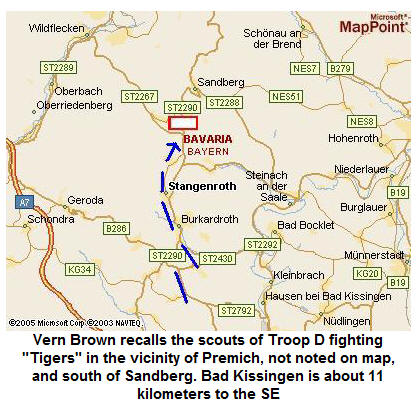
For Vern Brown and the men of Troop D, the war ended about one month
later, they went into temporary occupation duty in the Munich area.
The 14th Armored Davison had liberated over 110 , 000 Allied POWs in
the final weeks of the war.
At about the same time, in the small German city of Kotzting near the
Czech border and to the northeast at Trochau inside of Czechoslovakia,
the last men of the 2nd Panzer Division surrendered to local US
forces. A few days earlier, the order had been given that any soldiers
desiring to simply “ leave for home “ were free to go. The 2nd Panzer
Davison, that had fought in Poland, France ((1940)), Greece, Russia,
France (1944) and then the final defense of the Reich, ceased to
exist.
Long Time Gone
Where exactly were the
Panthers that Bill Heflin photographed in 1946? Between Brown and
Taggert, we get two very good clues: just SW of Steinach and on the
road leading east out of Premich. Geoff Walden, TACOM in Schweinfurt,
is back from his second tour in Iraq and has agreed to check the
locations to see if any of the horizon and tree lines in the photos
can be matched in the modern day. On the first pass through, nothing
matched up, however, Geoff vowed to try a second time. By the time
Bill took his photos, the tanks had taken on a “picked over“ look,
there may have been some souvenir hunters from the Army but much more
would have been removed by local scrap collectors.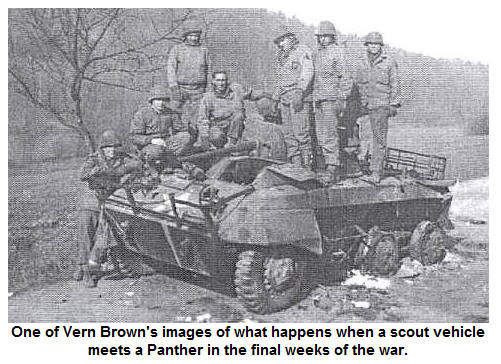
In immediate post war Germany, two ready sources of employment were
recycling bricks, window and door frames from bombed out cities and
collecting scrap steel from the battlefields. The once mighty Panthers
that were part of the last combat operation of the 2nd Panzer Division
would have slowly been whittled down, first by hand, then wrench and
finally with acetylene torches until nothing remained … except for
memories and Bill Heflin’s Panther photographs.
*UPDATE
Geoff Walden recently went and found the
places where these tanks met their ends. To view this update
click here
Enter the Internet
We researched this story in part by begging at some of the
outstanding World War II History and Armored Fighting Vehicle
discussion forums available on the Internet. As with all things, one
must be careful about the source, there is a lot of bad information
on the Internet but the better, fact driven sites usually
self-police and avoid the mud slinging and specious information that
can live forever on rant sites.
Without doubt the most extensive German military history English
language web site and forum page is
Jason Pipes’ one man monument to
research. In an ocean of on line rant rooms,
catalogues and porn, these sites represent the enormous power of the
Internet.
We posted the images of the Panther tanks and asked for opinions on
vehicle type and background associated with the last days of the 2
Panzer Division. After some argument and discussion, the consensus was
that the tanks were the model G types, the final production version,
see:
http://members.tripod.com/~dietmagic/panther.html and
http://www.achtungpanzer.com/intro.htm . The Feld Grau forums
provided great detail on the Thuringer Panzer Brigade and we even met
another US veteran from Daley Barracks on line … it’s a small world at
lightening speed.
Interestingly in Europe over the past few years a wonderful mixture
of historical research, backyard archeology and lets go dig up
some tanks!! thinking has led to many recoveries of once lost
German and Soviet WWII era vehicles. Dedicated hobbyists armed with
unit After Action Reports, metal detectors and bribes for local
farmers have fanned out from Normandy to the former Stalingrad to
seek battlefield relics. The former Soviet Union and Eastern block
countries have proven to be a particularly ripe picking fields. On
occasion, farmers simply buried tank hulks in convenient shell and
bomb holes to get post war farming under way. In 2005 here come the
guys with the Euros and the shovels!! Go
here and click the “Come
See the Battlefields“ icon.
In 1978, some of my NCOs who lived on the economy and had extensive
German contacts mentioned they had heard of a tank battle that had
taken place not too far from Bad Kissingen. The fight still lived at
the Stammtisch in a few of the village Gasthauses; the older Germans
recalled a victory. I made a mental note, vowed to see the area and
then never followed through. Sometimes these things take a while and
if you happen to stick a shovel in the ground by the road running east
out of Premich, you never know what you might find.
|
|